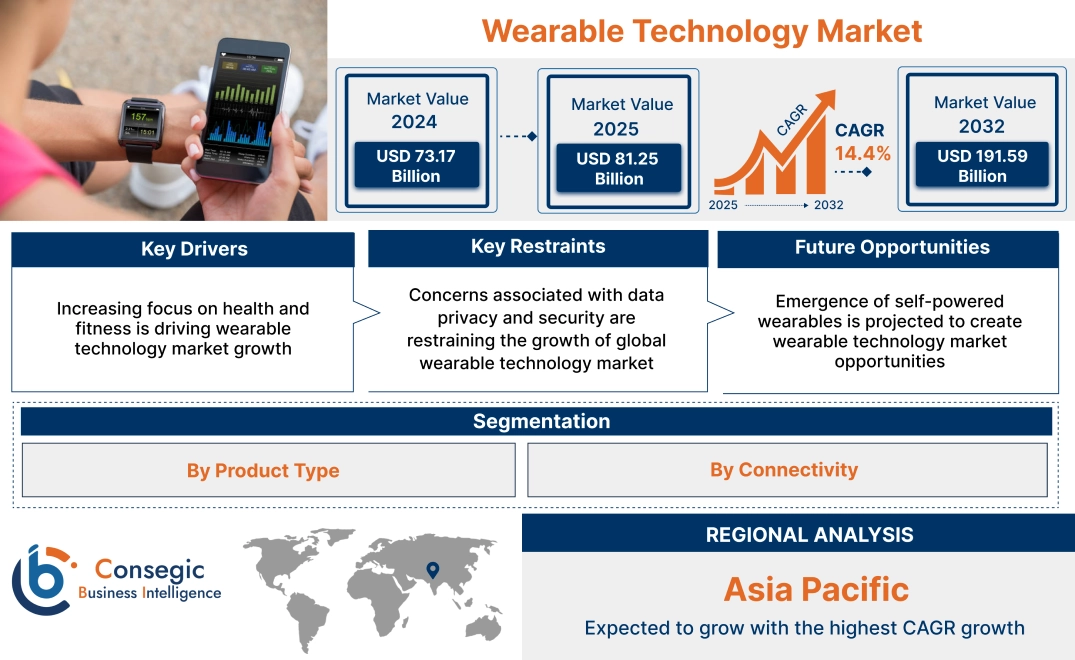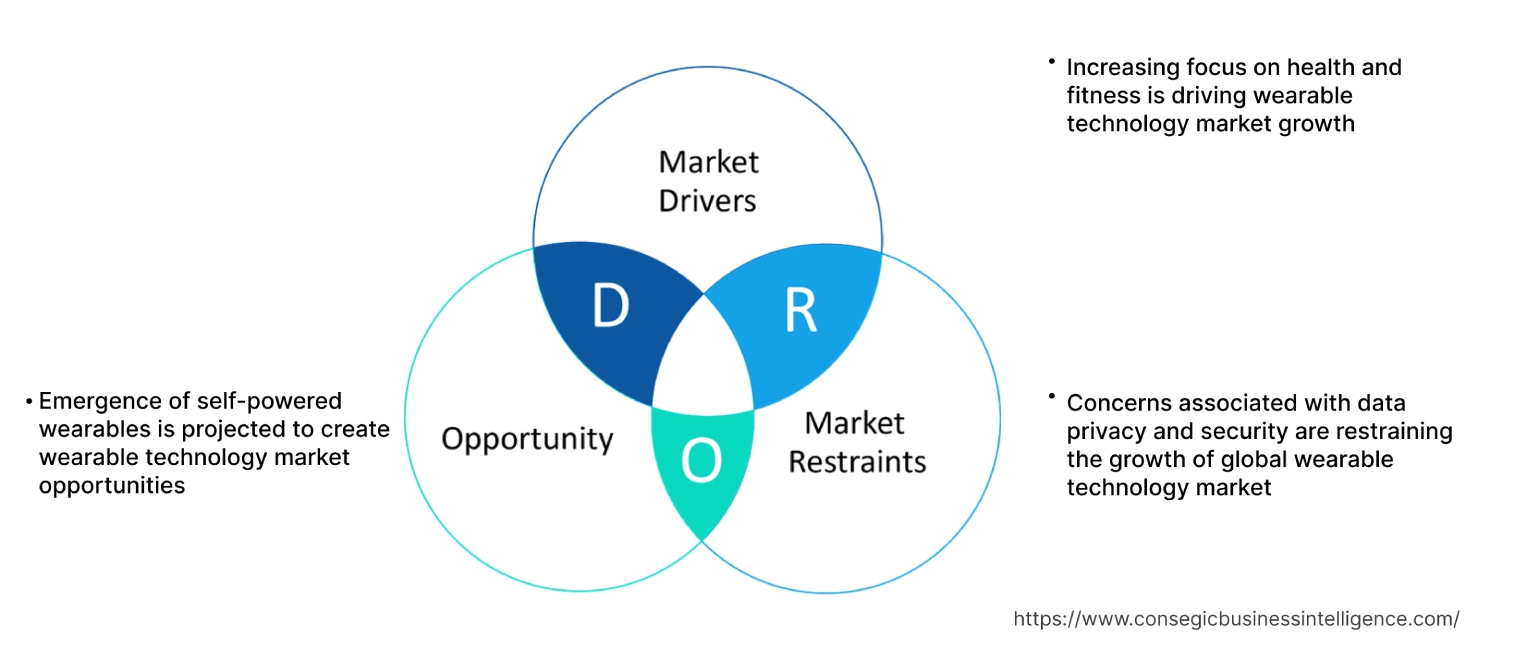- Summary
- Table Of Content
- Methodology
Wearable Technology Market Size:
Wearable Technology Market Size is estimated to reach over USD 191.59 Billion by 2032 from a value of USD 73.17 Billion in 2024 and is projected to grow by USD 81.25 Billion in 2025, growing at a CAGR of 14.4% from 2025 to 2032.
Wearable Technology Market Scope & Overview:
Wearable technology, referred to as "wearables," encompasses electronic devices designed to be worn on the body. These devices are equipped with sensors and connectivity capabilities, allowing them to collect, analyze, and transmit data. The data can range from health metrics like heart rate and activity levels to notifications and other forms of digital information. Common examples include smartwatches, fitness trackers, and smart glasses, which aim to provide users with convenient and accessible technology integrated into their daily lives.
Key Drivers:
Increasing focus on health and fitness is driving wearable technology market growth
People are becoming aware of the importance of maintaining a healthy lifestyle, which drives the demand for tools that can help them monitor and improve their well-being. Wearable devices, such as fitness trackers and smartwatches, provide users with real-time data on their activity levels, heart rate, sleep patterns, and other vital health metrics. Additionally, wearables play a crucial role in remote health monitoring, allowing individuals to track chronic conditions and share data with healthcare providers. The technology is particularly valuable for individuals with chronic diseases, the elderly, and those who require continuous monitoring, hence boosting the wearable technology market trend.
- For instance, in Jan 2024, Fitbit and Quest Diagnostics partnered in a pilot study, WEAR-ME, to investigate how combining data from Fitbit wearable devices with Quest's lab test results can enhance metabolic health management. The study aims to explore how this integrated data can be analyzed to improve disease prevention, particularly for conditions like diabetes and heart disease, by providing a more comprehensive view of an individual's health. This collaboration seeks to leverage the continuous tracking capabilities of wearables with the precision of laboratory diagnostics to create more effective health assessments.
Consequently, the increasing focus on health and fitness is driving the wearable technology market expansion.
Key Restraints:
Concerns associated with data privacy and security are restraining the growth of global wearable technology market
Wearable devices collect a vast amount of personal data, including health metrics, location information, and daily habits. This data, if compromised, can lead to identity theft, financial fraud, and other harmful consequences. Additionally, wearable devices often transmit data to smartphones or cloud-based platforms, creating vulnerabilities for data interception and unauthorized access. Moreover, users are often unaware of the extent to which their data is being collected, used, and shared, resulting in a loss of confidence and reluctance to embrace wearable devices, further restraining the global wearable technology market growth.
Therefore, as per the analysis, these combined factors are significantly hindering wearable technology market expansion.
Future Opportunities :
Emergence of self-powered wearables is projected to create wearable technology market opportunities
Self-powered wearables support the integration of advanced sensors that require continuous power, expanding the range of data collected and analyzed, leading to innovations in areas like industrial safety and sports performance. Additionally, continuous, uninterrupted monitoring of vital signs and health metrics will become possible, enabling more effective remote patient monitoring and chronic disease management. This is expected to revolutionize healthcare delivery and improve patient outcomes, thus boosting the wearable technology market demand.
- For instance, in Sep 2024, University of Washington researchers created a novel, flexible electronic device that converts body heat into usable electricity. The wearable prototype is designed for durability, maintaining functionality even after sustaining punctures and enduring extensive stretching. Technology holds promise for powering small electronic devices like sensors, LEDs, and batteries directly from the body's thermal energy, potentially leading to self-powered wearable technology.
Hence, based on the analysis, emergence of self-powered wearables is expected to create Wearable Technology market opportunities.
Wearable Technology Market Segmental Analysis :
By Product Type:
Based on the product type, the market is classified into wrist-wear, eye-wear, head-wear, foot-wear, neck-wear, body-wear, others.
Trends in the Product Type:
- Eye-Wear is experiencing significant growth, particularly in augmented reality (AR) and virtual reality (VR) applications.
- Growing trend towards the adoption of smart shoes and insoles in sports and fitness, providing data on biomechanics and performance.
Wrist-Wear accounted for the largest revenue of 41.93% in 2024.
- Wrist wear devices offer comprehensive health monitoring features like, ECG (electrocardiogram) monitoring, blood oxygen (SpO2) measurement, and advanced sleep analysis, driving the wearable technology market share.
- The trend of smartwatches evolving into smartphone extensions is gaining momentum, as they incorporate features like Bluetooth calling, notification management, and mobile payment functionalities.
- Moreover, manufacturers are prioritizing longer battery life, faster processors for smoother performance, and intuitive user interfaces.
- Furthermore, the growing trend towards kids wristwear is also contributing notably in accelerating the wearable technology market size.
- For instance, in December 2024, Bark Technologies introduced the Bark Watch, a smartwatch designed for children that prioritizes safety and parental control. The watch automatically scans texts, photos, and videos for potential risks, alerting parents to concerning content, thereby providing a controlled introduction to technology.
- Thus, as per the wearable technology market analysis, the aforementioned factors are driving the wrist wear segment growth.
Neck wear is predicted to register the fastest CAGR during the forecast period.
- To enhance wearability, manufacturers are diversifying materials, designs, and styles, even partnering with jewellery designers to produce visually appealing devices.
- Neck-worn devices are incorporating communication features like voice assistants and emergency alerts, which allows for hands-free communication and quick access to assistance in case of emergencies.
- Some neck-worn devices are integrating audio capabilities, utilizing bone conduction for private listening to music and notifications.
- Moreover, the emergence of advanced technology like advanced thermoelectric technology and a large cooling plate is also driving the wearable technology market size.
- For instance, in March 2025, TORRAS launched the COOLiFY Air, a lightweight, neck-worn personal cooling device designed for immediate and localized relief from heat. Utilizing thermoelectric technology and a large cooling plate, it provides a 360° cooling sensation, ensuring comfort throughout the day.
- Consequently, the aforementioned factors are driving the growth of neck-worn segment.
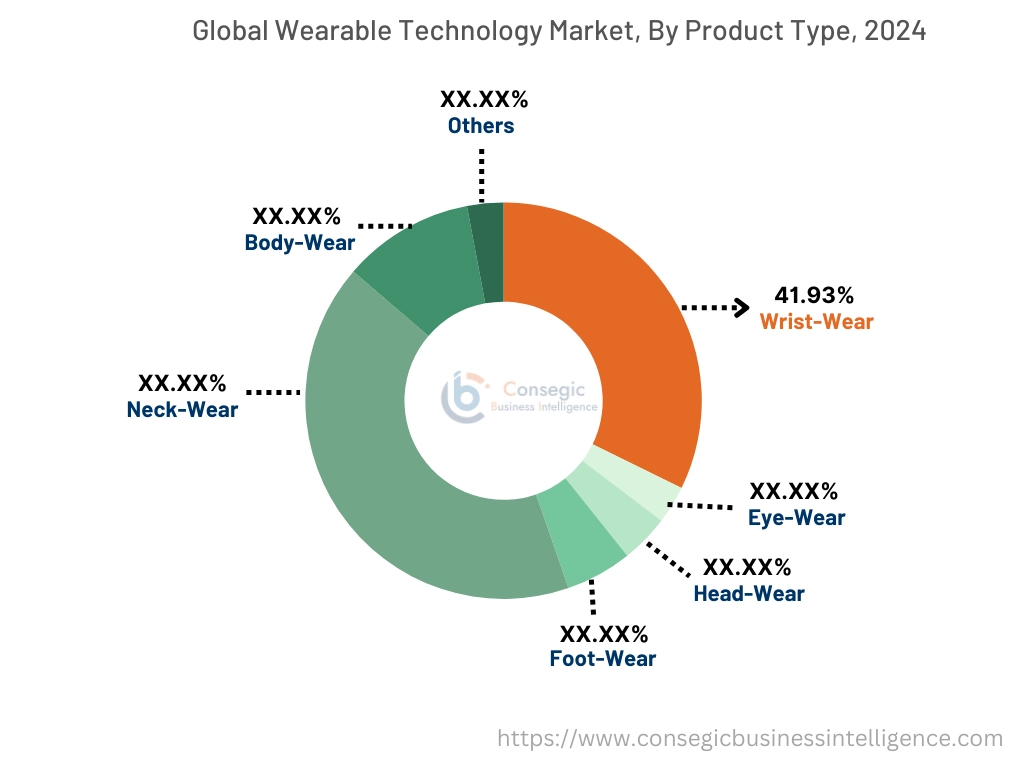
By Application:
Based on the application, the market is categorized into consumer electronics, healthcare, enterprise and industrial application, others.
Trends in Application:
- Wearables are used to monitor worker safety in hazardous environments, such as construction sites and factories.
- Growing trend towards the adoption of wearables for empowering individuals to take a proactive approach to their health by providing real-time data and insights.
Consumer Electronics accounted for the largest revenue share in 2024.
- Smartwatches and fitness trackers achieved widespread popularity by addressing the needs of consumers interested in fitness, health, and everyday convenience.
- Wearables are now seamlessly woven into daily routines, acting as smartphone extensions and enhancing everyday activities, thus driving wearable technology market demand.
- By prioritizing stylish designs and customization options, manufacturers are transforming wearables into fashionable accessories, further contributing to the wearable technology market growth.
- For instance, in September 2024, Apple launched Apple Watch Series 10, featuring a thinner design, a larger and more advanced display, and enhanced health and fitness capabilities. Key updates include new sleep apnea notifications, faster charging, water depth and temperature sensing for improved aquatic tracking, and advanced health and fitness insights powered by watchOS 11.
- Therefore, as per the market analysis, the aforementioned benefits are bolstering the wearable technology market trend.
Healthcare is predicted to register the fastest growth during the forecast period.
- Growing incidence of chronic illnesses and the expanding elderly population are fueling the demand for remote patient monitoring. Wearables provide vital sign and health metric tracking, hence driving the market demand.
- Wearables are proving invaluable in managing chronic conditions such as diabetes, heart disease, and respiratory illnesses. These devices provide real-time data and insights, empowering patients to manage their conditions more effectively.
- Further, the growing adoption of wearables in neuro health is also boosting the wearable technology market demand.
- For instance, in October 2024, MIT researchers created tiny, soft polymer wearable devices designed to interact with individual cells, specifically neurons. These battery-free devices, activated wirelessly by light, can wrap around neuronal components like axons and dendrites without causing damage. This allows for precise measurement and modulation of a neuron's electrical and metabolic activity at a subcellular level, potentially revolutionizing understanding and treatment of neurological conditions.
- Thus, as per the analysis, the aforementioned factors are driving the wearable technology market share.
Regional Analysis:
The regions covered are North America, Europe, Asia Pacific, the Middle East and Africa, and Latin America.
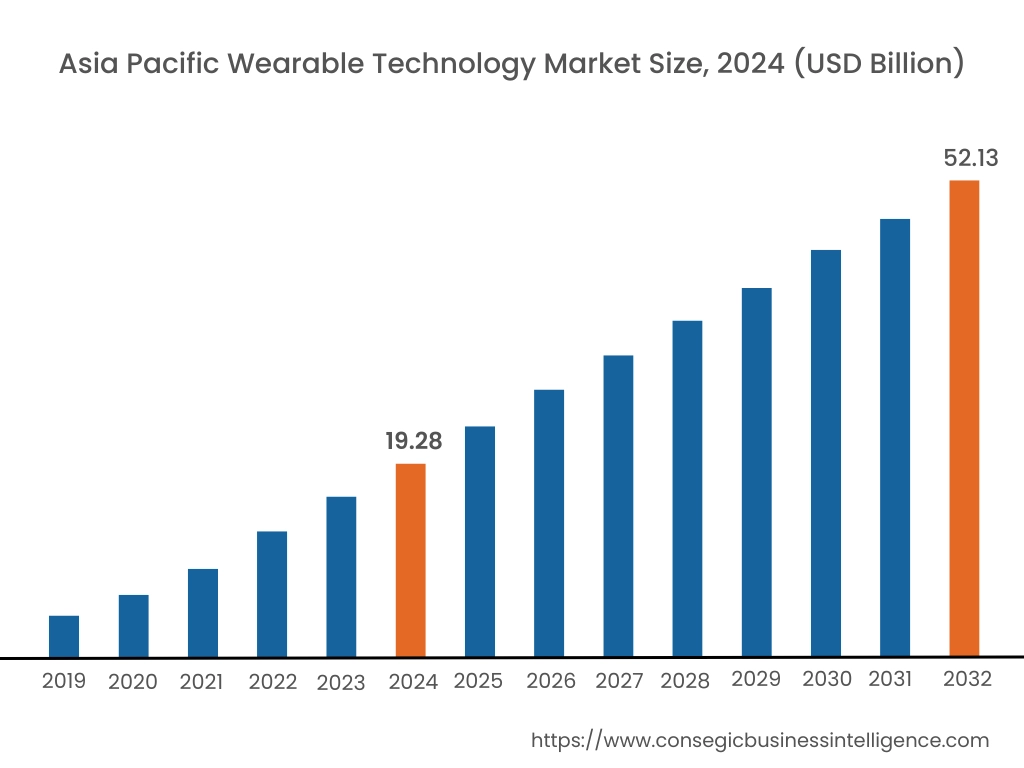
Asia Pacific region was valued at USD 19.28 Billion in 2024. Moreover, it is projected to grow by USD 21.47 Billion in 2025 and reach over USD 52.13 Billion by 2032. Out of these, China accounted for the largest revenue share of 36.52% in 2024.There is a rising focus on health and fitness across Asia-Pacific, driving demand for wearable devices that track activity, heart rate, and other vital signs. Additionally, the region is a hub for technological innovation, with high smartphone penetration and increasing internet connectivity. Moreover, many wearable device components and final products are manufactured in Asia-Pacific, contributing to competitive pricing and wider availability. The increase in the adoption of smart devices, such as smart watches, and smart ear buds, is significantly increasing the wearable technology industry.
- For instance, in June 2024, ASUS launched the VivoWatch 6, a premium smartwatch focused on advanced health tracking. Key features include a bright AMOLED display, built-in blood pressure and ECG monitoring, and the ability to measure body composition, sleep quality, and stress levels through a Relaxation Index and Body Harmony Analysis. Designed for all-day wear with a lightweight build, it also offers dual-band GPS and an impressive 14-day battery life, positioning it as a strong contender in the health-focused wearable market.
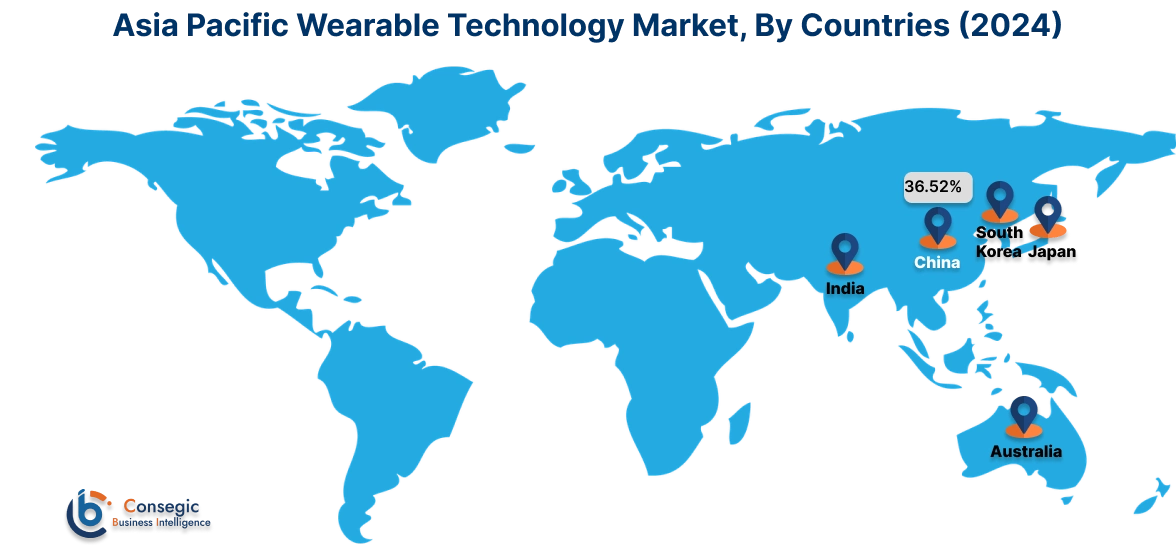
North America was valued at USD 24.51 Billion in 2024. Moreover, it is projected to grow by USD 27.19 Billion in 2025 and reach over USD 63.47 Billion by 2032. The region's advanced healthcare infrastructure facilitates the integration of wearable technology into healthcare applications, such as remote patient monitoring and chronic disease management. Additionally, the region is home to leading technology companies like Apple, Google (Fitbit), and Garmin, which are major drivers of innovation and market growth in the wearable space.
- For instance, Google's Pixel Watch 3 unveiled a groundbreaking health feature: Loss of Pulse Detection. This opt-in function automatically detects when a user's pulse disappears and, if they become unresponsive, triggers an emergency services call.
As per the wearable technology market analysis, European wearable technology market is experiencing steady rise driven by increasing health awareness and a strong focus on fitness. The region's developed healthcare systems and rising adoption of smartwatches and fitness trackers are key factors. Additionally, Latin American wearable market is expanding, spurred by increasing smartphone penetration and a growing middle class. Moreover, Middle East and Africa wearable market is witnessing significant expansion, particularly in urban centers where smartphone usage is high. Growing awareness of health and wellness, along with government initiatives promoting healthy lifestyles, further contribute to wearable technology market expansion.
Top Key Players and Market Share Insights:
The market is highly competitive with major players providing wearable technology to the national and international markets. Key players are adopting several strategies in research and development (R&D), product innovation, and end-user launches to hold a strong position in the market. Key players in the wearable technology industry include-
Recent Industry Developments :
Product Launches:
- In July 2023, Adidas launched its new SWITCH FWD line of high-performance shoes, emphasizing innovative design and engineering. Key features include strategically placed ventilation windows for improved airflow and a specially engineered EVA midsole with collapsing and springing voids to optimize forward momentum.
- In April 2023, Garmin has broadened the availability of its Dexcom Connect IQ apps, enabling individuals with diabetes using Dexcom's G6 or G7 CGM systems to track their glucose levels directly on compatible Garmin cycling computers and smartwatches.
- In July 2022, Qualcomm launched its new Snapdragon W5+ Gen 1 and W5 Gen 1 wearable platforms, aiming to significantly improve next-generation smartwatches and wearables. These platforms prioritize extended battery life and enhanced performance, enabling manufacturers to create sleeker, more innovative devices with premium user experiences.
Wearable Technology Market Report Insights :
| Report Attributes | Report Details |
| Study Timeline | 2019-2032 |
| Market Size in 2032 | USD 191.59 Billion |
| CAGR (2025-2032) | 14.4% |
| By Product Type |
|
| By Connectivity |
|
| By Region |
|
| Key Players |
|
| North America | U.S. Canada Mexico |
| Europe | U.K. Germany France Spain Italy Russia Benelux Rest of Europe |
| APAC | China South Korea Japan India Australia ASEAN Rest of Asia-Pacific |
| Middle East and Africa | GCC Turkey South Africa Rest of MEA |
| LATAM | Brazil Argentina Chile Rest of LATAM |
| Report Coverage |
|
Key Questions Answered in the Report
How big is the Wearable Technology market? +
The wearable technology market size is estimated to reach over USD 191.59 Billion by 2032 from a value of USD 73.17 Billion in 2024 and is projected to grow by USD 81.25 Billion in 2025, growing at a CAGR of 14.4% from 2025 to 2032.
What specific segmentation details are covered in the wearable technology report? +
The wearable technology report includes specific segmentation details for product type, application, and regions.
Which is the fastest segment anticipated to impact the market growth? +
In the wearable technology market, healthcare is the fastest-growing segment during the forecast period.
Who are the major players in the wearable technology market? +
The key participants in the Wearable Technology market are Apple (USA), Google (Fitbit) (USA), Samsung (South Korea), Xiaomi (China), Huawei (China), Garmin (USA), Imagine Marketing (boAt) (India), Whoop (USA), Oura (Finland), Amazfit (Zepp Health) (China), Polar (Finland), Fossil (USA), Withings (France), Dexcom (USA), COROS (USA), and Others.
